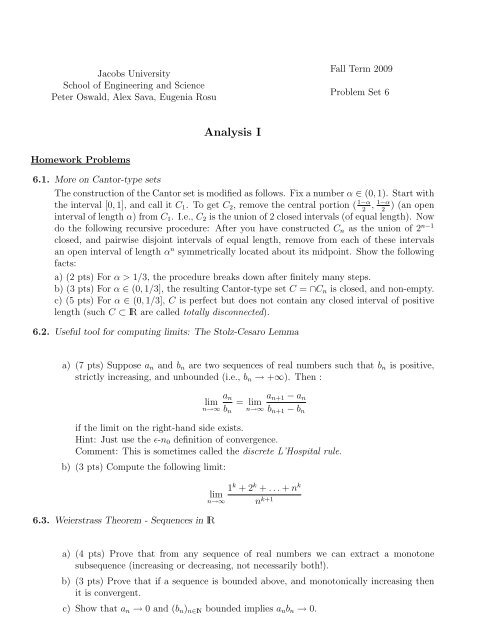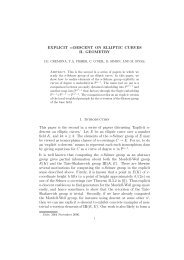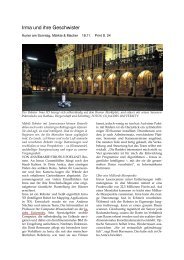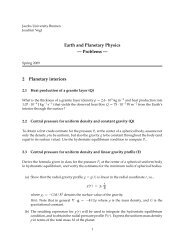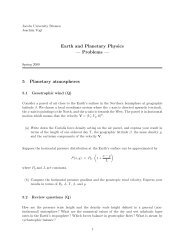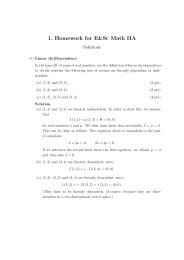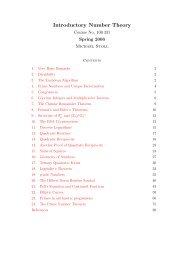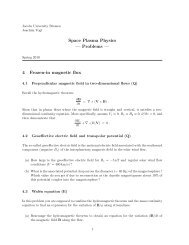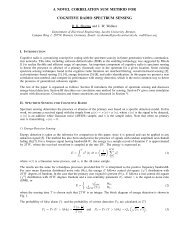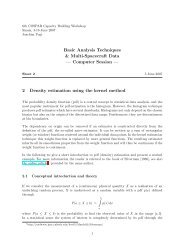Analysis I - Faculty.jacobs-university.de - Jacobs University
Analysis I - Faculty.jacobs-university.de - Jacobs University
Analysis I - Faculty.jacobs-university.de - Jacobs University
You also want an ePaper? Increase the reach of your titles
YUMPU automatically turns print PDFs into web optimized ePapers that Google loves.
<strong>Jacobs</strong> <strong>University</strong><br />
School of Engineering and Science<br />
Peter Oswald, Alex Sava, Eugenia Rosu<br />
Homework Problems<br />
<strong>Analysis</strong> I<br />
Fall Term 2009<br />
Problem Set 6<br />
6.1. More on Cantor-type sets<br />
The construction of the Cantor set is modified as follows. Fix a number α ∈ (0, 1). Start with<br />
the interval [0, 1], and call it C1. To get C2, remove the central portion ( 1−α 1−α , ) (an open<br />
2 2<br />
interval of length α) from C1. I.e., C2 is the union of 2 closed intervals (of equal length). Now<br />
do the following recursive procedure: After you have constructed Cn as the union of 2n−1 closed, and pairwise disjoint intervals of equal length, remove from each of these intervals<br />
an open interval of length αn symmetrically located about its midpoint. Show the following<br />
facts:<br />
a) (2 pts) For α > 1/3, the procedure breaks down after finitely many steps.<br />
b) (3 pts) For α ∈ (0, 1/3], the resulting Cantor-type set C = ∩Cn is closed, and non-empty.<br />
c) (5 pts) For α ∈ (0, 1/3], C is perfect but does not contain any closed interval of positive<br />
length (such C ⊂ IR are called totally disconnected).<br />
6.2. Useful tool for computing limits: The Stolz-Cesaro Lemma<br />
a) (7 pts) Suppose an and bn are two sequences of real numbers such that bn is positive,<br />
strictly increasing, and unboun<strong>de</strong>d (i.e., bn → +∞). Then :<br />
an<br />
lim<br />
n→∞ bn<br />
an+1 − an<br />
= lim<br />
n→∞ bn+1 − bn<br />
if the limit on the right-hand si<strong>de</strong> exists.<br />
Hint: Just use the ɛ-n0 <strong>de</strong>finition of convergence.<br />
Comment: This is sometimes called the discrete L’Hospital rule.<br />
b) (3 pts) Compute the following limit:<br />
6.3. Weierstrass Theorem - Sequences in IR<br />
1<br />
lim<br />
n→∞<br />
k + 2k + . . . + nk nk+1 a) (4 pts) Prove that from any sequence of real numbers we can extract a monotone<br />
subsequence (increasing or <strong>de</strong>creasing, not necessarily both!).<br />
b) (3 pts) Prove that if a sequence is boun<strong>de</strong>d above, and monotonically increasing then<br />
it is convergent.<br />
c) Show that an → 0 and (bn)n∈IN boun<strong>de</strong>d implies anbn → 0.
6.4. About the set of limit poits (= subsequential limits)<br />
a) (7 pts) Let (pn)n∈IN be a sequence in a metric space (X, d). Then the set of all limit points<br />
of (pn)n∈IN is closed.<br />
b) (3 pts) What do you think: Can any closed set E ⊂ IR be realized as the set of limit<br />
points of a certain sequence in IR? Could such a statement be true for any metric space?<br />
6.5. About upper and lower limits<br />
(10 pts) Prove that: lim sup(an+bn) ≤ lim sup an+lim sup bn. Try to show a similar property<br />
for lim inf.<br />
6.6. Bonus problem<br />
(10 pts) Consi<strong>de</strong>r the two recursively <strong>de</strong>fined sequences<br />
an+1 = an<br />
2<br />
5<br />
+ , bn+1 = bn + 2 −<br />
an<br />
b2n , n ≥ 1,<br />
5<br />
with starting values a1 = b1 = 2 in IR. Show that both sequences converge to the same limit<br />
L, and try to answer the question which one converges faster.<br />
Hint: First assume convergence, and find the limit value. After this, investigate the behavior<br />
of the respective error sequences ɛn = an − L and δn = bn − L.<br />
Due Date: Thursday Oct. 29, in class.


